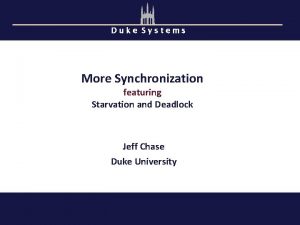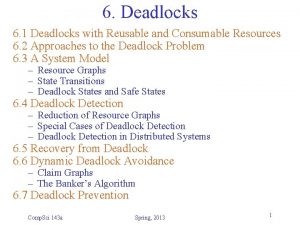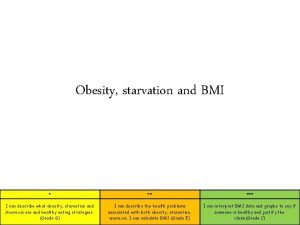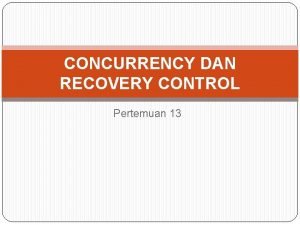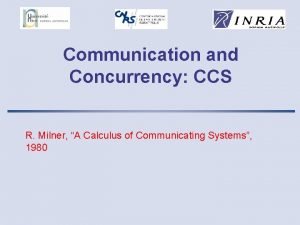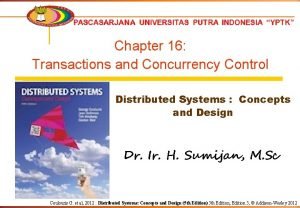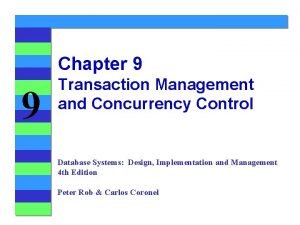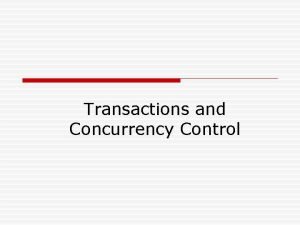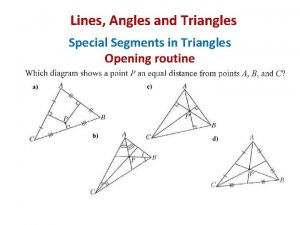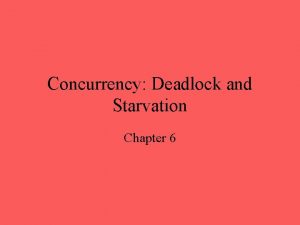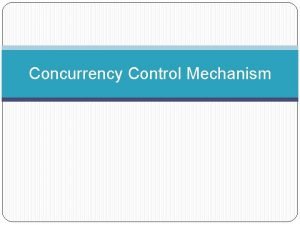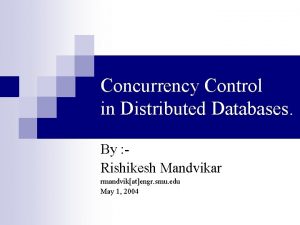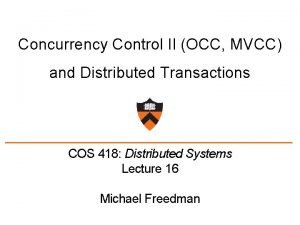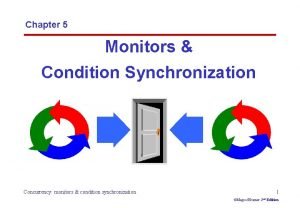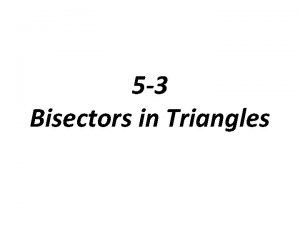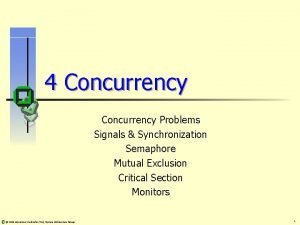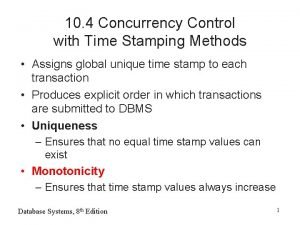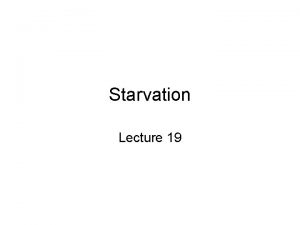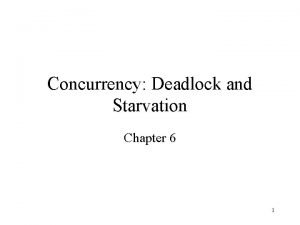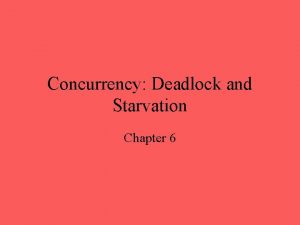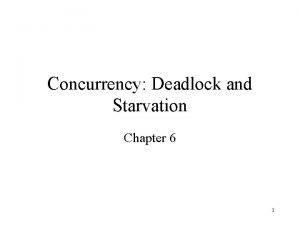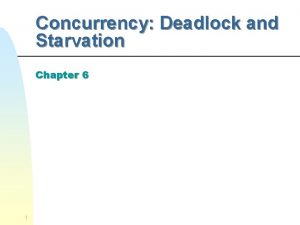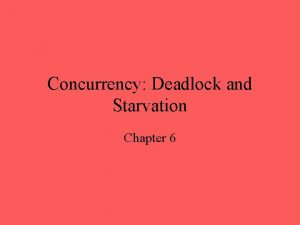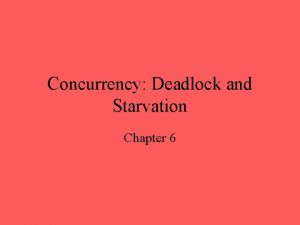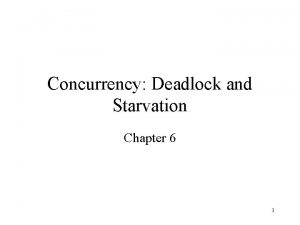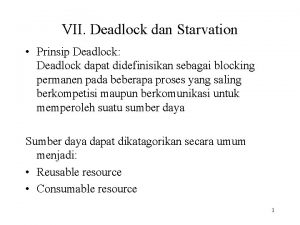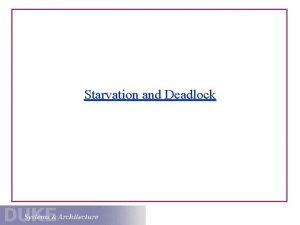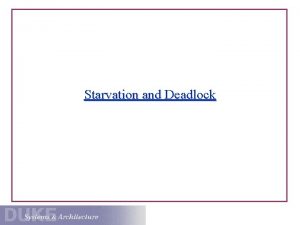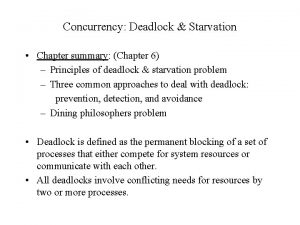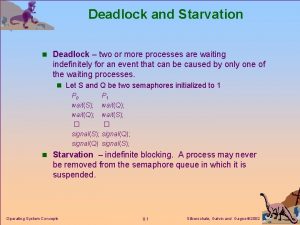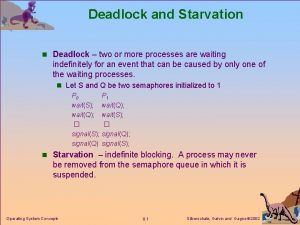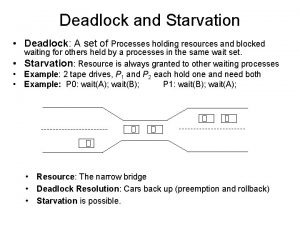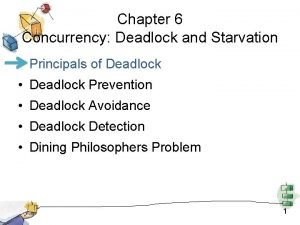Concurrency Deadlock and Starvation Principles of deadlock Deadlock









































- Slides: 41

Concurrency : Deadlock and Starvation • Principles of deadlock – Deadlock is the permanent blocking of a set of processes that either compete for system resources or communicate with each other. – Types of resources • Reusable – A reusable resource is one that can be safely used by only one process at a time and is not depleted by that use. – Examples: » processors, I/O channels, main and secondary memory, devices, files, data bases, semaphores • Consumable – A consumable resource is one that can be created and destroyed. – The number of consumable resources is usually unlimited. – When a resource is acquired by a process, the resource ceases to exist. – Examples: » interrupts, signals, messages, information in I/O buffers 1

Examples of deadlock • traffic deadlock • resource deadlock (reusable resources) – circular wait/deadly embrace • Process A holds resource 1 and is requesting resource 2. • Process B holds resource 2 and is requesting resource 1. • Deadlock occurs if each process refuses to free its acquired resources until it has obtained everything it requests for. • deadlock in spooling systems – A spooling system is used to improve system throughout by disassociating a program from the slow operating speeds of devices such as printers. – e. g. , printer operations • Printers are slow. • Output lines from a file are firstly routed to a faster device such as a disk drive, where they are temporarily stored until they may be printed. – Spool means simultaneous peripheral operations on line. – Throughput is the number of processes serviced per unit time. 2

3

4

5

6

Examples of deadlock (cont. ) • deadlock in spooling systems (cont. ) – In some spooling systems, the complete output from a program must be available before actual printing can begin. – Deadlock occurs if several partially completed jobs generating print lines to spool files fill up the available space. – If the OS administrator is still in control, he/she can kill some of the deadlocked processes until sufficient spooling space is available for the remaining jobs. • Otherwise, the system must be restarted, so that all jobs are lost. – remedy • Specify more spooling space in the OS, if this number must be preset. • OS stops admitting more spooling jobs when a saturation threshold of spooling space, say 75%, is reached. • Modern OS starts printing before the spooling files are completely copied into the disks. • dynamic allocation of spooling space 7

P 1 P 2 … … Request 80 Kbytes Request 70 Kbytes … … Request 60 Kbytes Request 80 Kbytes Another example of deadlock with main memory as reusable resource (assumption: total 200 Kbytes). Deadlock occurs if both processes progress to their second request. 8

Examples of deadlock (cont. ) • message deadlock – two processes, each waiting to receive a message from the other • This deadlock is difficult to detect. P 1 P 2 … … Receive (P 2); Receive (P 1); … … Send (P 2, M 1); Send (P 1, M 2); 9

Examples of deadlock (cont. ) – message deadlock (cont. ) • Suppose a server process and a client process run on two different machines. – The server first sends an initialization message to the client, and then waits for a request from the client. – The client first waits for the initialization message, and then makes requests. – If the two machines are of the same speed, and they are started simultaneously, then the system runs smoothly. – If, say in a few years, the server is upgraded to a high speed one -so fast that after the server’s initialization message arrives at the client, the client is still in its bootup stage, then the initialization message will be lost. – Thus, the client is waiting for the initialization message, whereas the server is waiting for a request message from the client. – A deadlock now occurs. 10

Starvation • This is the phenomenon where the scheduling of a process is delayed indefinitely while other processes receive the attention of the OS. • also called indefinite blocking or indefinite postponement • Starvation occurs because of biases in a system’s resource scheduling policies. – When resources are scheduled on a priority basis, it is possible for a given process to wait indefinitely for a resource as processes with higher priorities continue arriving. – remedy -- aging • Allow a process’s priority to increase as it waits for a resource. 11

12

Four Necessary conditions for deadlocks • Mutual exclusion condition – Processes claim exclusive control of the resources they require. • Hold-and-wait condition – Processes hold resources already allocated to them while waiting for additional resources. – The emphasis here is that not all resources requested are allocated at the same time. • No preemption condition – Resources cannot be removed from the processes holding them until the resources are used to completion. • Circular wait condition – A circular chain of processes exists in which each process holds one or more resources that are requested by the next process in the chain. 13

Four Necessary conditions for deadlocks (cont. ) • The four conditions are also sufficient for a deadlock to exist. – Given the first three conditions, a sequence of events may occur that leads to an unresolvable circular wait. • The circular wait is unresolvable because of the first three conditions. – The first three conditions are policies, whereas circular wait is a circumstance that might occur depending on the sequencing of requests and releases. 14

Deadlock prevention • • removes any possibility of deadlocks occurring may result in poor resource utilization most frequently used approach Strategies for denying necessary conditions (Havender 1968) – denying the mutual exclusion condition • This condition cannot be disallowed. – denying the hold-and-wait condition • Each process request all its required resources at once. • Resources are granted on an all or none basis. • If the complete set is not available, the process must wait. • While the process waits, it cannot hold any resources. • This strategy may cause indefinite postponement since not all the required resources may become available at once. – The process could also have started with only some of the resources. Thus the scheme causes unnecessary delay. 15

Deadlock prevention (cont. ) – denying the hold-and-wait condition (cont. ) • It leads to waste of resources. – The process is granted all its requested resources, but it does not need them all at the same time. – Remedy -- divide a program into several steps that run relatively independent of one another. – Each step controls its own resource allocation. – The remedy gives better resource utilization, but increases design and execution overhead. • charging problem – Whether to charge users for allocated but unused resources? – denying the no-preemption condition • When a process holding resources is denied a request for additional resources, that process must release its held resources. • The removed resources must be requested again. 16

Deadlock prevention (cont. ) – denying the no-preemption condition (cont. ) • When a process releases resources, it may lose all its work to that point. – Thus this approach applies only to resources whose state can be easily saved and restored later. • Indefinite postponement is possible since a process might repeatedly request and release the same resources. – In addition, system performance is degraded in performing the request and release operations. • Notice that denying the no-preemption condition is different from denying the hold-and-wait condition. – In the no-preemption condition, a process requesting 10 resources may ask for them one by one; as long as each request is fulfilled, the nopreemption condition is not violated. – In the no hold-and-wait condition, the same process must request all 10 resources at the same time. 17

Deadlock prevention (cont. ) – denying the circular wait condition • Each resource is uniquely numbered. • All processes must request resources in a linear ascending order. • difficulties – Resource numbers are preassigned during installation. – Addition of resources may cause problems, probably the modification of OS system programs. – Resource numbering usually reflects the normal ordering in which jobs use the resources. For jobs needing the resources in a different order than the assumed one, resources early in the line have to be requested and held idle for a long time, causing considerable waste. – Application programs may have to be reorganized to optimize for the linear ordering; this destroys the user transparency of resource management. – Deadlock prevention strategies are usually too conservative. 18

19

Deadlock detection • Resource requests are granted whenever possible. • Periodically, algorithms are run to detect the circular wait condition. • Resource allocation graph – is a directed graph. – Squares represent processes. – Large circles represent classes of identical devices. – Small circles within large circles represent the number of identical devices in each class. – Requests and allocations are indicated by arrows. • Deadlock detection by reducing resource allocation graphs – If a process’s requests may be granted, the resource allocation graph may be reduced by that process. • Remove the arrows to and from that process. – If a graph can be reduced by all its processes, there is no deadlock. 20

21

22

23

Deadlock detection (cont. ) • Deadlock recovery – Once deadlock has been detected, some strategy is needed for recovery. – The following are possible approaches, in order of increasing sophistication. 1. Abort all deadlocked processes. 2. Back up each deadlocked process to some previously defined checkpoint, and restart all processes. – Rollback mechanisms are needed. – After restarting, due to the nondeterminancy of concurrent processing, the original deadlock is unlikely to reoccur. 3. Successively abort deadlocked processes until deadlock no longer exists. – The order of abortion should be based on minimum cost. – After each abortion, reinvoke the detection algorithm again. 24

Deadlock detection (cont. ) 4. – Successively preempt resources until deadlock no longer exists. – The order of preemption is based on minimum cost. – A process that loses a resource must be rolled back to a point before its acquisition of that resource. For items 3 and 4, the selection criterion could be • least amount of processor time consumed so far, • least number of lines of output produced so far, • most estimated time remaining, • least total resources allocated so far, • lowest priority. 25

Deadlock detection (cont. ) • Difficulties in deadlock recovery – The priority order may be biased, such as the deadline of a small insignificant job. – Many systems have poor facilities for suspending a process indefinitely, removing it from the system, and resuming it at a later time. • not even <Ctrl-Z> in UNIX • Most systems do not have suspension facilities, and the removed processes are ordinary lost. • Even if suspension is possible, it involves considerable overhead and the attention of highly skilled operators. • Sometimes there is insufficient skilled manpower -- consider a deadlock involving tens or hundreds of processes. • Some systems have checkpoint/restart features, with a loss of the work since the last checkpoint; this still cost considerable effort on the application developers. • Real-time processes can simply not be suspended. • By not limiting resource access, deadlock detection is too liberal in restricting process actions. 26

Deadlock avoidance • Deadlock avoidance imposes less stringent conditions than in deadlock prevention in order to get better resource utilization. • All mutual exclusion, hold-wand-wait, and no-preemption conditions are allowed. • Judicious choices of allocation are made to assure that deadlock is never reached. • A decision is made dynamically on whether the current resource request could potentially lead to a deadlock. – Do not start a process if its demands might lead to deadlock. • See attached equations. – Do not grant an incremental resource request to a process if this allocation will lead to deadlock. 27

Deadlock avoidance (cont. ) • Dijkstra’s banker’s algorithm (1965) – The state of the system is the current allocation of resources to processes. – A safe state is one in which there is at least one order in which all processes can be run to completion within a finite time without resulting in a deadlock. (It is possible to go from a safe state to an unsafe state. ) – The OS is analogous to a banker, and job requests are analogous to the clients. – The system grants requests that result in safe states only. – Unsafe states need not be deadlocked ; there is only a potential for deadlock. The banker’s algorithm assures that there is never such a possibility. 28

29

30

31

32

33

Deadlock avoidance (cont. ) • Weakness in the banker’s algorithm – The total number of resources available is fixed, but resources frequently breakdown or require maintenance service. – The algorithm requires that the banker grant all requests within a finite time, but “finite time” is insufficient in real-time systems. – The algorithm requires that satisfied clients repay all loans within a finite time, but this may cause lengthy delay to other clients waiting in line. – Users must state their maximum resource usage in advance, but many jobs are interactive and dynamic and users cannot anticipate their eventual requirements. – The processes under consideration must be independent -- they cannot be constrained by any synchronization requirements. 34

An integrated deadlock strategy • Group resources into a number of different resource classes. • Use the linear ordering strategy defined for the prevention of circular wait to prevent deadlocks between resource classes. • Within a resource class, use an algorithm most appropriate for that class. • Example resource classes (in their order of assignment) – Swappable space • memory blocks in secondary storage • Use deadlock prevention by allocating all required space at one time, i. e. , disallowing the hold-and-wait condition. • Deadlock avoidance is also possible. – Process resources • assignable devices such as tape drives, files • Use deadlock avoidance because the total required resources are often known ahead of time. • Deadlock prevention is also possible. 35

An integrated deadlock strategy (cont. ) • Example resource classes (cont. ) – Main memory • in pages or segments • Use deadlock prevention by preemption because this is easy to do. – Internal resources • I/O channels • Prevention by means of resource ordering can be used. 36

The dining philosophers problem • Problem definition – There a number of philosophers, say five, who think and eat intermittently. – There are five plates on the table, and five forks set in between the plates. – Each philosopher is assigned his own plate. – Each philosopher needs both forks on each side to eat. – No two philosophers can use the same fork at the same time (mutual exclusion). – If each philosopher picks up the fork on the left and wait for the fork on the right, deadlock occurs. – Question: find an algorithm that allows the philosophers to eat, meanwhile avoiding deadlock and starvation. 37

38

39

40

41
 Deadlock and starvation
Deadlock and starvation Deadlock and starvation
Deadlock and starvation![Deadlocked in time [ch. 6 part 2] Deadlocked in time [ch. 6 part 2]](data:image/svg+xml,%3Csvg%20xmlns=%22http://www.w3.org/2000/svg%22%20viewBox=%220%200%20200%20200%22%3E%3C/svg%3E) Deadlocked in time [ch. 6 part 2]
Deadlocked in time [ch. 6 part 2] Starvation vs deadlock
Starvation vs deadlock Starvation vs deadlock
Starvation vs deadlock Deadlock vs livelock
Deadlock vs livelock Starvation deadlock
Starvation deadlock Starving in fire fighting
Starving in fire fighting Flow starvation waveform
Flow starvation waveform Chapter 5 nutrition guidelines tools for healthful eating
Chapter 5 nutrition guidelines tools for healthful eating Beyonce bmi
Beyonce bmi Starvation diabetes mellitus
Starvation diabetes mellitus Coif hair musical
Coif hair musical Principles of deadlock
Principles of deadlock Pessimistic concurrency control
Pessimistic concurrency control Apa yang dimaksud dengan recovery
Apa yang dimaksud dengan recovery Ccs milner
Ccs milner Safety and liveness in concurrency
Safety and liveness in concurrency Transactions and concurrency control in distributed systems
Transactions and concurrency control in distributed systems Transaction management and concurrency control in dbms
Transaction management and concurrency control in dbms Example of concurrency control in dbms
Example of concurrency control in dbms Special segments in triangles practice
Special segments in triangles practice Transaction management and concurrency control
Transaction management and concurrency control Point of concurrency of a triangle
Point of concurrency of a triangle Definition of point of concurrency
Definition of point of concurrency Concurrency in web applications
Concurrency in web applications Concurrency definition geometry
Concurrency definition geometry Ue4 tmap thread safe
Ue4 tmap thread safe Unix concurrency mechanisms
Unix concurrency mechanisms Concurrency control mechanism
Concurrency control mechanism Concurrency control in distributed databases
Concurrency control in distributed databases Timemasters locks
Timemasters locks Ada concurrency
Ada concurrency Nested state diagram in uml
Nested state diagram in uml Concurrency
Concurrency Introduction to subprogram level concurrency
Introduction to subprogram level concurrency Concurrent lines medians and altitudes
Concurrent lines medians and altitudes 5-3 bisectors in triangles
5-3 bisectors in triangles Semaphore concurrency
Semaphore concurrency Concurrency visualizer
Concurrency visualizer Statement level concurrency
Statement level concurrency Time stamping in database
Time stamping in database
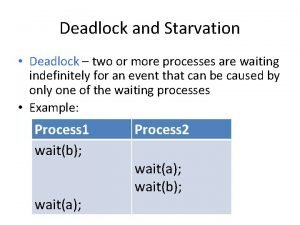

![Deadlocked in time [ch. 6 part 2] Deadlocked in time [ch. 6 part 2]](https://slidetodoc.com/wp-content/uploads/2021/03/4924895_2b47774288878079cc9245da8c4d6b36-300x225.jpg)
